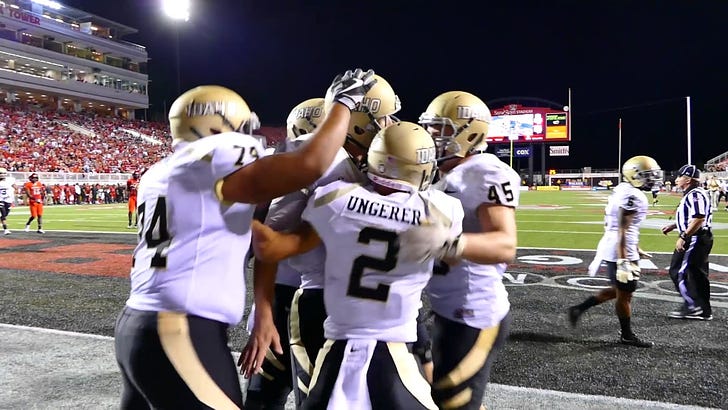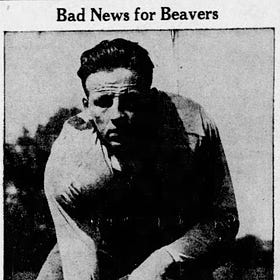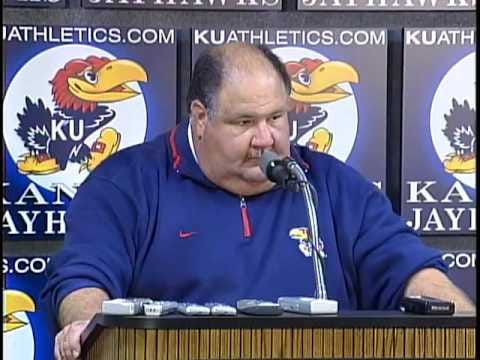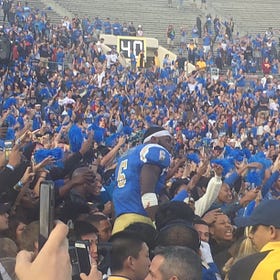Under the cloud of uncertainty looming on the Pac-12 Conference rings a common refrain that 108 years of history are going by the wayside for, what increasingly looks like, media conglomerates to have inventory on their streaming boondoggles.
It’s a point I have echoed, and it is technically true despite this not being the first time the Conference of Champions died.
Yes, the Pac-12 does indeed boast a legacy dating back to 1915 with the formation of the Pacific Coast Conference. However, the Pacific Coast Conference did indeed fold at one point.
The May 25, 1959 Associated Press wire report opens like so:
SEATTLE — The 44-year-old Pacific Coast Conference was laid to rest Sunday in a rare aura of unanimity. The nine pallbearers — the faculty representatives of the ex-member schools — pledges themselves to retain a “warm, personal friendship.”
This vote marked the culmination of a lengthy process that began three years prior at the University of Washington. A February 1956 AP report describes “[a] ‘quiet and judicial’ study of the University of Washington’s athletic finances and administrative procedures” in the wake of football coach John Cherberg being fired the month prior due to a “‘players’ rebellion.’”
One single thread coming loose at Washington resulted in a state senator getting involved into allegations of major violations. The more that thread was pulled, the more collective malfeasance throughout the PCC was revealed: UCLA, which represented the conference in the 1956 Rose Bowl Game, was found to have had players being paid under the table.
UCLA’s investigation led to investigation at USC, which led to investigations at Cal.
Basically, the PCC of the 1950s was the forerunner to the Southwest Conference of the 1980s1 and the SEC of the 1990s2.
Really, though, the death of a scandal-plagued PCC was more akin to a rebrand than declaring bankruptcy. Cal, UCLA, USC and Washington had already set up their next league, the Athletic Association of Western Universities.
Of the other five PCC schools initially out of the AAWU, four not-so-gradually joined: First Stanford, just prior to the 1959 football season; then Washington State in 1962; followed by the Oregon schools in 1964.
And then there was Idaho.
Oregon State and Washington State find themselves in a peculiar spot as their fate hangs in limbo.
Pac-12 Tuesday: An Oregon State vs. Washington State Timeline
The Week 4 matchup pitting Oregon State vs. Washington State stood out even before both the Beavers and Cougars entered into the AP Poll, making this the first-ever Top 25 meeting between the programs. That’s a remarkable tidbit, given the two Pacific Northwest land-grant universities have played consistently since 1903. This prompted me to revisit the …
21st Century conference expansion has been exactly that: Expansion. The so-called power leagues have grown their membership from conferences that lack the same financial perks.
While there are plenty of instances of programs leaving one “power” conference for another, there has not been an instance of a program from one of the autonomous leagues being left out of the Big 12 after the Southwest Conference crumbled almost 30 years ago.
Texas vs. Kansas and The Death of the Big 8 Conference
Kansas-Texas isn’t a particularly noteworthy college football series on its face. Dominated by the Longhorns for almost its entirety since 1996, the record sits at 17-2 Texas post-World War II. Conference championship implications rarely ride on a KU-Texas matchup. Hell, in Kansas’ unforgettable 2007 campaign, the programs never played. Ditto 1998, mean…
Perhaps one could make the case for the holdovers when the Big East ceased operations after the 2012 season. However, the American Athletic Conference launched designated as one of the outsider leagues.
As for examples of individual programs leaving power conferences without an equivalent landing spot? There was Tulane’s departure from the SEC in 1964, though Tulane University brass made that choice.
Idaho was simply excluded when the others formed their successor to the PCC.
Consider the AAWU and the Pac-8 that eventually grew from it the No Palouses Club. One Palouse, Washington State, was fine. Two was a no-go.
Now, I have long had a place in my heart for Idaho football. I ran a few seasons with the Vandals on NCAA Football 2003 for Playstation 2. The Kibbie Dome is on my college football bucket list for reasons I’d like to think are more genuine than mean-spirited sickos gawking but rather a genuine appreciation of the venue’s uniqueness.
Kyle Bonagura did justice to all that makes the Kibbie Dome so interesting in this ESPN.com piece. Definitely give it a read.
My interest in the Vandals grew from pixel-inspired curiosity to a real appreciation during the 2009 season when they reached their first bowl game since 1998.
Coach Robb Akey promised ESPN watchers during his halftime interview to stay tuned to the second half of the 2009 Humanitarian Bowl — “You’re gonna love it!” he declared — and boy, was he correct.
Idaho’s 43-42 defeat of Bowling Green ranks among my favorite games I ever watched on TV. I thought a lot about the Humanitarian Bowl when Idaho faced an uncertainty about its football future a few years later with the Sun Belt Conference declaring it would no longer host affiliate members.
The Sun Belt always felt like a strange spot for Idaho, and it was the Vandals’ last home league as a Football Bowl Subdivision program. It was also Idaho’s fourth (or second, depending on chronology) conference and one of five affiliations in a tumultuous 21st Century.
Idaho played out the end of the Big West as a football-sponsoring conference in 2000 — the Big West died in no small part due to numerous California programs folding in the previous decade.
Two-Team Town: A History of College Football in Los Angeles
Maybe it’s the San Gabriel Mountain backdrop against which the Rose Bowl sits, or the iconic Hollywood sign and skyscrapers of downtown Los Angeles visible from Los Angeles Memorial Coliseum. Perhaps credit belongs to the contrast of USC’s cardinal-and-gold against UCLA’s blue-and-gold, making for what’s undeniably the most aesthetically pleasing unifor…
The Vandals joined the Sun Belt for the first time in 2001, then got the call to join the Western Athletic Conference in 2005.
A more detailed examination of the WAC’s deterioration is in the cards; until then, it’s worth noting the league had been maybe the greatest conference outside of the traditional names like the Big Ten, Pac-12, SEC and Big 8. When Idaho joined, the WAC was less than a decade removed from featuring coaching luminaries like Fisher DeBerry, LaVell Edwards, Sonny Lubick and Joe Tiller.
And while the many factors that fractured the WAC and led to the formation of the Mountain West forced out Air Force, BYU, Colorado State and Wyoming — the programs those coaching legends led — Idaho aligned with a new wave of game-changing teams.
Pat Hill built Fresno State from a strong foundation into a nationally renowned program that would take on anyone, any time. June Jones’ introduction of the Run & Shoot at Hawai’i contributed to the generational transformation of football into a more pass-oriented game during the early 2000s, while Chris Ault’s Pistol set laid out the blueprint for programs that wanted to incorporate some of the sport’s new-fangled concepts while remaining committed to old-school, power football.
And then there was Idaho’s in-state rival and former Big Sky Conference counterpart Boise State. A school that wasn’t even a university until 15 years after Idaho’s exclusion from the AAWU, Boise State grew into a football powerhouse in remarkably short order.
Boise State was coming off a perfect regular season when Idaho first joined the WAC, suffering its only loss in a fantastic Liberty Bowl against Louisville. That game was more befitting the quality of a BCS matchup than most of the BCS bowls that season.
The year following Idaho’s move to the WAC, Boise State scored the definitive victory for all programs in conferences deemed less-than by administrators and executives.
That’s all to say that the version of the WAC Idaho joined in 2005 was the closest to being in league with college football’s upper echelon the Vandals had been since 1959. It took almost a half-century, but Idaho was back.
Until it wasn’t. A 46-year odyssey was undone in seven when this version of the WAC fell apart as a result of conference realignment.
And, like when the AAWU was formed and one-by-one readded old Pacific Coast Conference members, Idaho was left out. Only this time, Vandals football had shown much more promise.
There’s no easy way to state this: Idaho was bad in the PCC. No Vandals team produced an overall record better than .500 since 1938; none were over .500 in PCC play since Charles Erb’s co-championship-winning team3 in 1927.
AAWU schools had 30 years of precedent to suggest Idaho simply wasn’t able to compete and may never do so. But just before the Big West folded, the Vandals won the conference and went to the 1998 Humanitarian Bowl.
Their return there in 2009 — a season in which Boise State went undefeated and won a top-tier bowl that exited because of the Western Athletic Conference — suggested the Vandals could compete in a quality FBS league.
And, after the Sun Belt took its stand regarding full-time membership, the 2016 Idaho team went to another Humanitarian Bowl4 to complete a nine-win season.
Idaho leadership opting to rejoin the Big Sky Conference in football, and thus return to Football Championship Subdivision competition, made logistical and financial sense. I won’t lie, though, I do wonder how the program might have done joining Sun Belt refugee New Mexico State in independence for a half-decade until the Conference USA opportunity came along.
With that said, the 2023 Vandals are ranked in the FCS Top 5. Second-year coach Jason Eck is an energetic leader overseeing an exciting team that reflects his enthusiasm.
Idaho might very well be the best team in FCS. Wresting that title away from defending champion South Dakota State might take a Herculean effort, but the Vandals may have the firepower to do so between 2022 Jery Rice Award-winning quarterback Gevani McCoy, dynamic running back Anthony Woods and perhaps the best receiver in FCS, Hayden Hatten.
Pounding former WAC counterpart Nevada earlier this season made a statement.
I don’t doubt at all that if it was in the Mountain West this season, Idaho would make a bowl game — and might even contend for a spot in the league championship game. But is another potential December trip to Boise for the Potato Bowl better than competing for a national championship?
That’s a rhetorical question with a subjective answer that varies depending on your perspective. Neither answer is right nor wrong — just as no one can definitively say Idaho ever would have grown into being a fit for the Pac-8 and later the Pac-10 before becoming the Pac-12 had the Vandals been invited to the AAWU.
Either way, Idaho boasting a team of championship caliber after all the times it’s been left without a home is much deserved.
SMU’s receipt of the “Death Penalty” in 1987 is the most well-known of the SWC scandals, but every program in the conference save three were hit with some kind of NCAA sanctions throughout the decade.
Both Alabama and Auburn were slapped with some of the most significant penalties the NCAA has doled out in the last 40 years — SMU notwithstanding — during the ‘90s.
“Co-champions” is a stretch, too. Idaho went 2-0-2 and played none of the California schools, including fellow co-champion USC and Stanford. The Trojans and Cardinal were both 4-0-1 and no consideration was given to Idaho for the Rose Bowl berth.
Well…sorta. It had rebranded as the Famous Idaho Potato Bowl by 2016, but it’s the same game.






